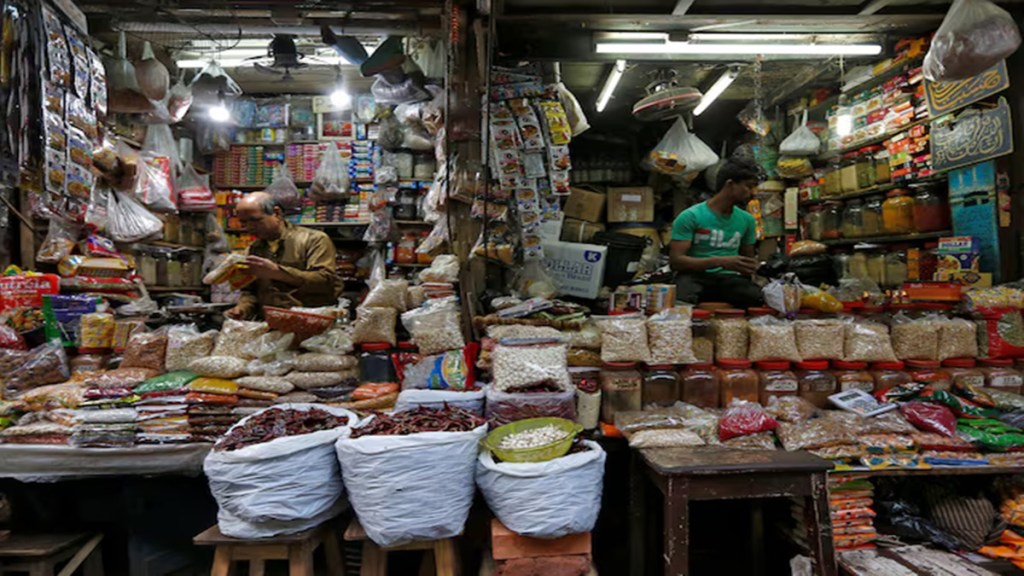As the debate on whether to cut the weight of food in the retail inflation index rages, the latest survey has shown a marginal increase in food’s share in household consumption, and a resultant dip in discretionary spending on other items like durable goods, education, and medicines.
This raises fresh questions on the strength of consumption demand in the economy, and bears out high-frequency data that reveal a slowing of urban consumption.
According to the Household Consumption Expenditure Survey (HCES) 2023-24, the share of food items in the average monthly per capita consumption expenditure (MPCE) of households in rural areas has risen to 48.43% from 47.47% in 2022-23; in urban areas, the rise was to 40.31% from 39.7%.
Besides, cereals’ share in MPCE has also risen to 7.6% in 2023-24 from 6.92% in 2022-23, in the rural areas, and in urban areas, to 4.8% from 4.51%.
Consequently, the share of non-food items in rural areas’ MPCE has declined to 52.96% in 2023-24 from 53.62% in 2022-23; and in urban areas to 60.32% from 60.83%.
Meanwhile, the survey showed that the urban-rural gap in MPCE has declined to 71% in 2022-23 from 84% in 2011-12. It has further come down to 70% in 2023-24 that “confirms sustained momentum of consumption growth in rural areas”, the statistics ministry said in a release.
“Increased spending on food items by households is a direct consequence of high food inflation,” said Indranil Pan, chief economist, Yes Bank. “But less spending on discretionary items also shows a decline in consumption, partly due to low real-wage growth this year,” Pan added.
Former Reserve Bank of India (RBI) governor Shaktikanta Das had stated in the latest MPC minutes that lower inflation will enhance disposable income with households and increase their purchasing power. “Such an approach would support consumption and investment demand,” he said.
In August 2023-July 2024, the reference period of the HCES 2023-24, food inflation averaged 8.3% against 6% in the same period of last year, whereas CPI inflation during the period averaged 5.1% against 6.1% in August 2022-July 2023.
The survey revealed that, in nominal prices, the average MPCE (without imputation) in 2023-24 increases by about 10% in rural areas to Rs 4,247 and 8% in urban areas to Rs 7,078 from the level of 2022-23.
The HCES 2023-24 was conducted by the National Statistical Office (NSO) from August 2023 to July 2024. It was followed by the HCES 2022-23, which was conducted after a gap of 11 years.
The HCES 2022-23 is going to be used to constitute the new Consumer Price Index (CPI) series, which is likely to be introduced in February 2026, sources say. The base year of the new CPI series will be updated to 2024 from 2012 at present.
According to sources, the government may reduce the weight of the “food and beverages” group by a little over 5 percentage points (pps) in the new CPI series. In the extant one, the group carries a weight of 45.86%. The weight of Consumer Food Price Index (CFPI), presently 39.06%, is also likely to reduce by a similar degree.
FE had reported in September that according to preliminary analysis, “HCES 2023-24 results are largely similar to the one of 2022-23”, citing a senior official.
Sources say the HCES 2023-24 was conducted for two reasons: checking robustness of the methodology adopted to conduct the 2022-23 survey; and ensuring that the previous survey results were not influenced by pent-up demand.
Among the key findings of HCES 2022-23 was that monthly per capita consumption “more than doubled” in the 11 years to 2022-23– it grew by roughly 1.5 times from 2011-12. During the period, the urban-rural gap continued to narrow –down 13 percentage points–and food’s share in the consumption basket continued to drop (from 53% to 47%). A sharp fall in cereals’ share in the consumption basket – from 10.7% to 6.9% in rural India – was also found.
In 2023-24, the consumption inequality, both in rural and urban areas, too, declined from 2022-23. The Gini coefficient has declined to 0.24 in 2023-24 from 0.27 in 2022-23 for rural areas, and to 0.28 from 0.31 for urban areas.
In the case of rural areas, while consumption spending rose 22.1% on year in 2023-24 for the lowest 0-5% of the households, spending of the top 95-100% shrunk by 3.5%. In the case of urban areas, consumption spending of the poorest households rose 18.7% on year, while the richest witnessed a 2.5% decline.
The survey showed that “beverages, refreshments and processed food” continue to have the major share in 2023-24 in the food items basket of the rural and urban households. And “conveyance, clothing, bedding & footwear, miscellaneous goods & entertainment and durable goods” have a major share in non-food expenditure.
The estimates of MPCE of 2023-24 are based on the data collected from 261,953 households (154,357 in rural areas and 107,596 in urban areas) across the country.
Among the states, the MPCE is the highest in Sikkim (rural – Rs 9,377 and urban – Rs 13,927) and it is the lowest in Chhattisgarh (rural – Rs 2,739 and urban – Rs 4,927). Among the UTs, MPCE is the highest in Chandigarh (rural – Rs 8,857 and urban – Rs 13,425), whereas it is the lowest in Dadra and Nagar Haveli and Daman and Diu (Rs 4,311) and Jammu and Kashmir (Rs 6,327) in rural and urban areas, respectively.
The rural-urban difference in the average MPCE among the states is the highest in Meghalaya (104%) followed by Jharkhand (83%) and Chhattisgarh (80%), the data showed. Also, the average MPCE in 9 out of 18 major states is higher than the all-India average MPCE in both rural and urban areas, it showed.


